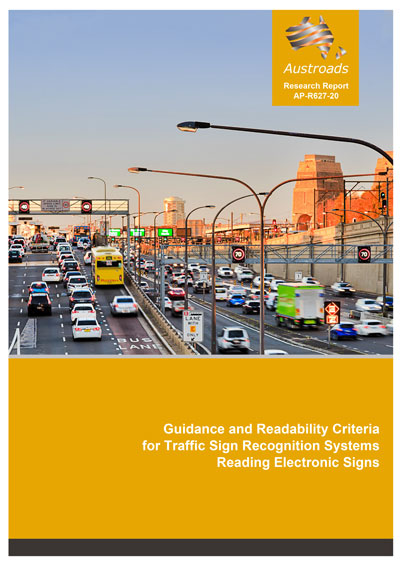Traffic Management

- Publication no: AP-R627-20
- ISBN: 978-1-922382-08-5
- Published: 20 August 2020
- PDF (free) Download
This report proposes electronic sign readability criteria for use by jurisdictions in the design and testing of electronic signs. It considers the requirements of traffic sign recognition systems in current vehicles and those soon to enter the market.
It follows work undertaken in 2018 that identified that that leadership was required on readability criteria for electronic signs as it impacts a range of electronic assets including motorway and school zone Variable Speed Limit signs (VSLS), Lane Use Management Signs (LUMS) and Variable Message Signs (VMS).
The 2020 study found that emerging technologies and updates to standards in progress go some way to mitigating the issues previously observed. A coordinated drive is still needed across all road agencies to deliver harmonisation of the on-road assets and the standards used to test and validate these.
- Summary
- 1. Introduction
- 1.1 Context
- 1.2 Purpose
- 1.3 Scope of the Project
- 1.4 Methodology
- 1.4.1 Stage 1: Understanding Current and Near-future Technologies
- 1.4.2 Stage 2: Assess Gaps to Existing Technologies and/or Near-future Technologies: Develop New Criteria and Requirements
- 1.4.3 Stage 3: Consolidated Reporting
- 1.5 Audience
- 1.6 Relevant Terms
- 2. Current Electronic Traffic Signs and Technologies
- 2.1 Traffic Sign Recognition (TSR) Systems
- 2.2 Traffic Signs
- 2.2.1 Electronic/Variable Speed Limit Signs (ESLS/VSLS)
- 2.2.2 Integrated Speed and Lane Use Signs/ Lane Use Management Systems (ISLUS/LUMS)
- 2.2.3 Variable Message Signs (VMS)
- 2.2.4 Electronic Message Signs (EMS)
- 2.2.5 Changeable Message Signs (CMS)
- 2.2.6 Ramp Control (RC) Signs
- 2.2.7 Portable/Trailer Signs (Portable VMS)
- 2.3 Legacy Devices
- 2.3.1 Flip Pixel/Dot/Disc Displays
- 2.3.2 Fibre Optic Displays
- 2.3.3 Neon / Fluorescent Tube Illuminated Displays
- 2.4 Australian Standards
- 2.4.1 Variable Speed Limit Signs
- 2.4.2 Variable Message Signs
- 2.5 New Zealand Traffic Control Devices
- 2.6 Recognition of Electronic Signs
- 3. Literature Review
- 3.1 Evaluation Process
- 3.2 National and International Specifications
- 3.2.1 Australia
- 3.2.2 New Zealand
- 3.2.3 International
- 3.3 Related Austroads Projects
- 3.3.1 Implications of Traffic Sign Recognition
- 3.3.2 Infrastructure Changes to Support AVs Asset Standards – Module 3
- 3.3.3 Infrastructure Changes to Support AVs Asset Standards – Road Audit Module 2
- 3.3.4 Review of Sign Size for Electronic Regulatory Speed Signs
- 3.4 Trials
- 3.4.1 Transurban VIC
- 3.4.2 Transurban NSW
- 3.4.3 Transurban QLD
- 3.5 Testing
- 3.5.1 Australasian New Car Assessment Program (ANCAP)
- 3.6 Research Papers
- 3.6.1 LED Flicker Reduction
- 3.6.2 LED Text
- 3.6.3 Colour Consistency, Contrast and Adaptability to Ambient Light
- 4. Stakeholder Consultation
- 4.1 Project Reference Group Consultation
- 4.2 External Consultation
- 4.2.1 Electronic Sign Manufacturers
- 4.2.2 Vehicle Manufacturers
- 4.2.3 TSR and Camera Systems
- 5. Industry Challenges
- 5.1 Findings Review
- 5.1.1 Vehicle Manufacturers
- 5.1.2 TSR and Camera Systems
- 5.1.3 Electronic Sign Manufacturers
- 5.2 Gap Analysis
- 5.2.1 LED Flicker
- 5.2.2 Colour, Contrast and Uniformity
- 5.2.3 Display Form, Shape and Fonts
- 5.1 Findings Review
- 6. Conclusion and Recommendations
- 6.1 Harmonisation Challenges
- 6.2 TSR Readability Criteria
- 6.3 Further Work with Standards Australia
- 6.4 Project Recommendations
- 6.5 Further Work
- References
- Appendix A Transport Agency Specifications
- A.1 Department of Transport (formerly VicRoads)
- A.2 Department of Transport and Main Roads
- A.3 Transport for New South Wales (formerly Roads and Maritime Services)
- A.4 Main Roads Western Australia
- A.5 Department of Planning, Transport and Infrastructure
- A.6 Transport Canberra and City Services
- A.7 New Zealand Transport Agency
- Appendix B Stakeholder Consultation
- B.1 PWG Survey Questions
- B.2 PWG Request for Asset Data
- B.3 Sign OEM Survey Questions
